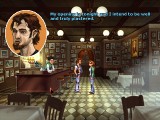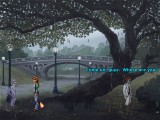Dear readers, though this article focuses primarily on the 3rd instalment to Wadjet Eye Games’ “Blackwell” series, The Blackwell Convergence, we are subsequently also to publish a second, combined number on the 1st and 2nd episode. Please bear with me as we progress, in reverse order, to achieve some degree of relevancy.
Both parts will also touch upon topics beyond the make-up of a “review”; whether we should chalk them up to “analysis” or “discussion” remains open for interpretation. Should you agree or disagree, let us know what you think in the comment section! Finally, if you are yet to familiarize yourself with this ongoing series of adventures, I do hope you should come back to check out part 1/2. The easiest way to find out when is to either subscribe to our Twitter (http://www.twitter.com/slowdownvg) or to our RSS feed (http://www.slowdownvg.com/feed/)!
In its most oft-applied format, the first paragraph to reviews of indie adventure games often touches upon resolution and pixel art, with glancing references to “retro”, “VGA” or “MIDI”, coined with comparisons including but not limited to Monkey Island. In this particular register, turns of phrases like “go back in time”, “a return to the age of” or “the good old days” are prevalent if not altogether ubiquitous. In closing, then, we should agree that the game under review is worth its moderate price tag and a generous three stars.
Instead of utilizing the aforementioned paradigm – building parallels, making comparisons and bridging together references – I would rather focus, this time, on facets that separate, on features that differentiate. While I do admit that each game bears traces of its influences (this particular game’s designer is pleasantly forthcoming about his 1)http://www.adventurecorner.de/pages.php?id=326), with the Blackwell series, nevertheless, the one distinguishable element I want to pay closer attention to is its fervent, methodical application and utilization of real-world puzzles and conversations, characters and locations. It is these factors that ultimately push the game over the biggest hurdle in today’s adventure gaming, that is, an overbearing reliance on the fantastic and the historical. The Blackwell series, despite its paranormal leanings, operates within a convincing blend of fact and fiction.
Before we delve deeper in, however, let us briefly go back to the core fundamentals. The Blackwell Convergence, third 2)Technically speaking – there exists a prequel, called Bestowers of Eternity, that functions in the same game universe of a series, is a commercial point-and-click indie adventure game, built upon Chris Jones’ popular Adventure Game Studio engine. The game, written and programmed by Dave Gilbert (also of The Shivah fame), discusses the women of a family beleaguered by their innate, involuntary ability to create a link to the spirit world.
In each of the three last generations of the Blackwell family, a woman has discovered her capacity to function as a medium at some point in her life, each to varying degrees of success. All have also been forcibly bonded to the very same spirit guide, Joey Mallone, because there exists a seemingly unbreakable link in-between the medium and her guide that prevents one from leaving the immediate company of the other.
Over the span of some six months, the leading lady of the first game, Rosangela Blackwell, has grown slightly more accustomed to her new role as medium, perhaps simply because she has little choice in the matter: Not only is Mallone not going anywhere, but such pairings are the only ones able to help spirits trade their physical trappings for the eternal, spirits that are left behind when violently ripped from the wheel of life, creating a regressed dependence to the time and place of their death and a strong denial of their non-existence.
For those who felt the earlier parts of the series were justly critiqued for their “commonplace” premise and “formulaic” nature 3)http://www.adventuregamers.com/article/id,718/, then, Convergence may seem to offer little new at first fright: Once again, the game introduces to us a new class of souls in peril. The major revelation found within, however, is very closely related to this seeming repetition, as I discovered a substantial upgrade to Gilbert’s treatment of the dichotomy of the old and the new, junior and senior: Where Legacy and Unbound relied strongly on temporal and generative themes and concepts, Convergence is much less reliant on these. I hope to clarify this further in part 1/2.
The end result, in any case, is a fleshier canvas of character interaction – best exhibited within the bounds of an art gallery – and a new-found willingness to engage on Rosa’s part. Though not obvious at first, it would seem to me that these little adjustments are very significant in the context of the overarching storyline. While the changes cannot exactly be called subtle, they nevertheless begin to bridge together the various generations found within in the game, simultaneously allowing the characters to become more fully rounded. This comes after the fact that the writer himself found Rosa perhaps too “scared and nervous” 4)http://indygamer.blogspot.com/2007/12/dave-gilbert-interview.html in the first instalment.
Several examples of the aforementioned character development can be named: At the opening of the art gallery mentioned above, the player can choose between partying late (and hard!) or leaving early. This choice results in Rosangela receiving two very different sets of reactions from the rest of the cast. Similarly, the delightfully odd Nishanti Sharma, Rosa’s neighbour, is no longer as unperturbedly insistent on mothering Rosangela, as the two have come considerably closer to resembling peers. The same can be said of Joey; although he still has his pockets full of snide remarks and a domineering turn of phrase, after six months of working with Rosa, he too sees her as more of a partner than an apprentice.
To say something of the tangibles, Convergence is the most polished Blackwell so far: Shane Stevens’ redrawn character art and animations are true to existing source material, and leave me expectant and hopeful for future “deluxe” editions of the earlier games. Herculean Effort’s Ian Schlaepfer continues to contribute evocative, colourful portraiture, something that was sorely missing in Legacy, and the backgrounds were successfully sourced to Luminous Arts. A notable feature to the game is the constant presence of rain.
Thomas Regin is back at the musical helm, continuing largely on the stylistic path set by the first game. The production values for the music, too, have increased along with the rest of the game’s façade: The lounge-y, jazzy soundtrack is lusher, thicker, a more fully realized affair.
Of note to players already familiar with the series is the fact that the game’s notes system has been truncated somewhat. Left out is the possibility of combining clues in order to deduce solutions to problems. This is slightly unfortunate, as this particular omission does make the game considerably easier. Similarly, because Convergence’s gameplay is tremendously polished overall, the combination of the two-button use/look interface and the now-streamlined note system in turn reflect negatively on the overall length of the game.
As far as the voice acting goes, Rebecca Whittaker, the replacement voice for Sande Chen’s Rosa, is sassier and perkier; subtle enough, in any case, to be well-enough suited to the ongoing character development illustrated above. Abe Goldfarb (Gilbert’s made man), then, has irreplaceably become Joey Mallone. Nonie Craige‘s Nishanti is also more to my personal preference than the first game’s by Ruth Weber, but all in all, since the voice cast is professional through and through, perhaps it was simply an easier task for Whittaker to convey a more socially apt Rosa? An interesting detail is how players can constantly consult Joey for information and new ideas during the game. He is hardly ever short of new, fully contextual lines of dialogue to respond with, and indeed many a line of dialogue have been written and recorded for this feature alone.
Now, to finally get back to my original premise of differentiation: While the game, plot-wise, does little to somehow miraculously separate itself from its primary genre of paranormal detective fiction, in fact moving closer still to that particular mode of writing, what is ultimately more important, overall, is the quality of the actual storyline: Detective fiction requires meticulous pacing, planning and execution, and at that, Convergence succeeds. In fact, we’ve only really begun to understand the depth and extent of the narrative, with the game taking one step forward by essentially taking another backwards.
We can either lambast the game for the tangibility of its storyline or its puzzles for being too obvious or “commonplace”, or we could simply accept that these very same factors greatly add to the overall verisimilitude and ambience of the gameplay. For instance, some of the more chore-like actions, like having to log on to Rosa’s e-mail (or “B-Mail” as it is called in jest) account or “Oogling” for information does, in a very understated way, involve us in the character’s everyday life.
This type of everyday-based experience is also visible on the general characterization and serves, in my mind, to remove some of the more contrived video game oppositions from the game. Unlike most games, in which the spirit world of ghosts and altered states are often simply blatant symbols and vessels for conveying “enemy” or “danger”, in Blackwell, the spirits are ambivalent and often represent failure – in life, or death, or both.
The significance of this cannot be understated, as it means the series contains few clear-cut antagonists – or protagonists, for that matter. The spirit world is, instead of generating dissidence or schism, utilized in blending together the game’s fact and fiction. Gilbert’s incorporation of some very real characters and situations creates a clever literary mix that borders on alternative history, gently twisting and squeezing reality to produce necessary results.
Such utilization of real-world characters also gives the game a dangerous edge not altogether apparent at first glance. Gilbert, in his commentary for the game, explains how he felt especially uneasy about a scene that incorporates several real (though now deceased) persons. The potency of this particular scene is further doubled when Gilbert himself voices one of the characters in the scene. It is at this very moment in the game that we begin to lose our grasp of the voices present: Who, exactly, is speaking? What’s being said?
This is intriguing in relation to the series’ primary motif of Jungian interconnectedness and synchronicity – especially so with Convergence, which proceeds to take one step further towards opening the mechanisms of the spirit world to the player.
In an earlier post, I expressed some concern over the comedic Blackwell video shorts being potentially damaging to the characters. This fear turned out to be unfounded insofar it relates to the actual game. It must be said, however, that Convergence, like its two predecessors, nevertheless fluctuates between two modes of dialogue: biting irony and sarcasm on the one hand and sentimentality on the other. This does ultimately result in the characters becoming slightly less relatable at times, as if the game was part Cosmopolis, part White Noise – and unable to choose. While I’m going to discuss these sitcom-like qualities in the forthcoming “first” part in further detail, to those with experience of the New York lifestyle and US television programming, this register may already be perfectly familiar.
So many words, so few conclusions. In this article, I’ve attempted to illustrate that Gilbert’s “Blackwell” is an ambitious, literary series with intricate, reality-based narrative design, fully rounded characterization, books for sources and inspiration, and New York City for a heart.
Have you played anything like that in a while?
The Blackwell Convergence is available now, for the price of $14.99, from Wadjet Eye Games and Direct2Drive, and over the course of the next weeks, at Big Fish, PlayFirst, and iWin. A demo version of the game is also available on the Wadjet Eye Games website.
References
| 1. | ↑ | http://www.adventurecorner.de/pages.php?id=326 |
| 2. | ↑ | Technically speaking – there exists a prequel, called Bestowers of Eternity, that functions in the same game universe |
| 3. | ↑ | http://www.adventuregamers.com/article/id,718/ |
| 4. | ↑ | http://indygamer.blogspot.com/2007/12/dave-gilbert-interview.html |











